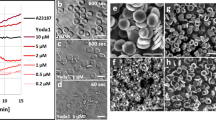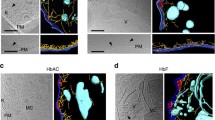Abstract
Survival of the malaria pathogen Plasmodium falciparum in host erythrocytes requires the opening of new permeability pathways (NPPs) in the host cell membrane, accomplishing entry of nutrients, exit of metabolic waste products such as lactate and movement of inorganic ions such as Cl−, Na+ and Ca2+. The molecular identity of NPPs has remained largely elusive but presumably involves several channels, which partially can be activated by oxidative stress in uninfected erythrocytes. One NPP candidate is aquaporin 9 (AQP9), a glycerol-permeable water channel expressed in erythrocytes. Gene-targeted mice lacking functional AQP9 (aqp −/−) survive infection with the malaria pathogen Plasmodium berghei better than their wild-type littermates (aqp9 +/+). In the present study whole-cell patch-clamp recordings were performed to explore whether ion channel activity is different in erythrocytes from aqp −/− and aqp9 +/+ mice. As a result, the cation conductance (K+ > Na+ > Ca2+ ≫ NMDG+) was significantly lower in erythrocytes from aqp −/− than in erythrocytes from aqp9 +/+ mice. Oxidative stress by exposure for 15–30 min to 1 mM H2O2 or 1 mM tert-butyl-hydroperoxide enhanced the cation conductance and increased cytosolic Ca2+ concentration, effects significantly less pronounced in erythrocytes from aqp −/− than in erythrocytes from aqp9 +/+ mice. In conclusion, lack of AQP9 decreases the cation conductance of erythrocytes, an effect that possibly participates in the altered susceptibility of AQP9-deficient mice to infection with P. berghei.






Similar content being viewed by others
References
Atamna H, Ginsburg H (1993) Origin of reactive oxygen species in erythrocytes infected with Plasmodium falciparum. Mol Biochem Parasitol 61:231–241
Atamna H, Ginsburg H (1997) The malaria parasite supplies glutathione to its host cell—investigation of glutathione transport and metabolism in human erythrocytes infected with Plasmodium falciparum. Eur J Biochem 250:670–679
Atamna H, Pascarmona G, Ginsburg H (1994) Hexose-monophosphate shunt activity in intact Plasmodium falciparum-infected erythrocytes and in free parasites. Mol Biochem Parasitol 67:79–89
Barry PH, Lynch JW (1991) Liquid junction potentials and small cell effects in patch-clamp analysis. J Membr Biol 121:101–117
Becker K, Gui M, Traxler A, Kirsten C, Schirmer RH (1994) Redox processes in malaria and other parasitic diseases. Determination of intracellular glutathione. Histochemistry 102:389–395
Bhavsar SK, Bobbala D, Xuan NT, Foller M, Lang F (2010) Stimulation of suicidal erythrocyte death by alpha-lipoic acid. Cell Physiol Biochem 26:859–868
Bhavsar SK, Gu S, Bobbala D, Lang F (2011) Janus kinase 3 is expressed in erythrocytes, phosphorylated upon energy depletion and involved in the regulation of suicidal erythrocyte death. Cell Physiol Biochem 27:547–556
Boassa D, Stamer WD, Yool AJ (2006) Ion channel function of aquaporin-1 natively expressed in choroid plexus. J Neurosci 26:7811–7819
Bobbala D, Alesutan I, Foller M, Huber SM, Lang F (2010) Effect of anandamide in Plasmodium berghei-infected mice. Cell Physiol Biochem 26:355–362
Brand VB, Sandu CD, Duranton C, Tanneur V, Lang KS, Huber SM, Lang F (2003) Dependence of Plasmodium falciparum in vitro growth on the cation permeability of the human host erythrocyte. Cell Physiol Biochem 13:347–356
Breuer WV, Kutner S, Sylphen J, Ginsburg H, Cabantchik ZI (1987) Covalent modification of the permeability pathways induced in the human erythrocyte membrane by the malarial parasite Plasmodium falciparum. J Cell Physiol 133:55–63
Desai SA, McCleskey EW, Schlesinger PH, Krogstad DJ (1996) A novel pathway for Ca++ entry into Plasmodium falciparum-infected blood cells. Am J Trop Med Hyg 54:464–470
Desai SA, Bezrukov SM, Zimmerberg J (2000) A voltage-dependent channel involved in nutrient uptake by red blood cells infected with the malaria parasite. Nature 406:1001–1005
Dibas A, Yang MH, Bobich J, Yorio T (2007) Stress-induced changes in neuronal aquaporin-9 (AQP9) in a retinal ganglion cell-line. Pharmacol Res 55:378–384
Duranton C, Huber S, Tanneur V, Lang K, Brand V, Sandu C, Lang F (2003) Electrophysiological properties of the Plasmodium falciparum-induced cation conductance of human erythrocytes. Cell Physiol Biochem 13:189–198
Eberhard M, Ferlinz K, Alizzi K, Cacciato PM, Faggio C, Foller M, Lang F (2010) FTY720-induced suicidal erythrocyte death. Cell Physiol Biochem 26:761–766
Egee S, Lapaix F, Decherf G, Staines HM, Ellory JC, Doerig C, Thomas SL (2002) A stretch-activated anion channel is up-regulated by the malaria parasite Plasmodium falciparum. J Physiol 542:795–801
Felder KM, Hoelzle K, Ritzmann M, Kilchling T, Schiele D, Heinritzi K, Groebel K, Hoelzle LE (2011) Hemotrophic mycoplasmas induce programmed cell death in red blood cells. Cell Physiol Biochem 27:557–564
Foller M, Kasinathan RS, Koka S, Lang C, Shumilina E, Birnbaumer L, Lang F, Huber SM (2008) TRPC6 contributes to the Ca2+ leak of human erythrocytes. Cell Physiol Biochem 21:183–192
Foller M, Bobbala D, Koka S, Huber SM, Gulbins E, Lang F (2009) Suicide for survival—death of infected erythrocytes as a host mechanism to survive malaria. Cell Physiol Biochem 24:133–140
Gatidis S, Zelenak C, Fajol A, Lang E, Jilani K, Michael D, Qadri SM, Lang F (2011) p38 MAPK activation and function following osmotic shock of erythrocytes. Cell Physiol Biochem 28:1279–1286
Ghashghaeinia M, Toulany M, Saki M, Bobbala D, Fehrenbacher B, Rupec R, Rodemann HP, Ghoreschi K, Rocken M, Schaller M, Lang F, Wieder T (2011) The NFkB pathway inhibitors Bay 11-7082 and parthenolide induce programmed cell death in anucleated erythrocytes. Cell Physiol Biochem 27:45–54
Ginsburg H (1994) Transport pathways in the malaria-infected erythrocyte. Their characterization and their use as potential targets for chemotherapy. Biochem Pharmacol 48:1847–1856
Ginsburg H, Atamna H (1994) The redox status of malaria-infected erythrocytes: an overview with an emphasis on unresolved problems. Parasite 1:5–13
Ginsburg H, Kirk K (1998) Membrane transport in malaria-infected erythrocyte. In: Sherman IW (ed) Malaria: parasite biology, pathogenesis, and protection. American Society for Microbiology, Washington DC, pp 219–232
Huber SM, Uhlemann AC, Gamper NL, Duranton C, Kremsner PG, Lang F (2002) Plasmodium falciparum activates endogenous Cl− channels of human erythrocytes by membrane oxidation. EMBO J 21:22–30
Huber SM, Duranton C, Lang F (2005) Patch-clamp analysis of the “new permeability pathways” in malaria-infected erythrocytes. Int Rev Cytol 246:59–134
Kirk K (2001) Membrane transport in the malaria-infected erythrocyte. Physiol Rev 81:495–537
Kirk K, Horner HA (1995) Novel anion dependence of induced cation transport in malaria-infected erythrocytes. J Biol Chem 270:24270–24275
Kirk K, Horner HA, Spillett DJ, Elford BC (1993) Glibenclamide and meglitinide block the transport of low molecular weight solutes into malaria-infected erythrocytes. FEBS Lett 323:123–128
Kristoff J (2007) Malaria stage-specific vaccine candidates. Curr Pharm Des 13:1989–1999
Kuriyama H, Kawamoto S, Ishida N, Ohno I, Mita S, Matsuzawa Y, Matsubara K, Okubo K (1997) Molecular cloning and expression of a novel human aquaporin from adipose tissue with glycerol permeability. Biochem Biophys Res Commun 241:53–58
Kutner S, Breuer WV, Ginsburg H, Cabantchik ZI (1987) On the mode of action of phlorizin as an antimalarial agent in in vitro cultures of Plasmodium falciparum. Biochem Pharmacol 36:123–129
Lang KS, Lang PA, Bauer C, Duranton C, Wieder T, Huber SM, Lang F (2005) Mechanisms of suicidal erythrocyte death. Cell Physiol Biochem 15:195–202
Lang F, Huber SM, Szabo I, Gulbins E (2007) Plasma membrane ion channels in suicidal cell death. Arch Biochem Biophys 462:189–194
Lang PA, Kasinathan RS, Brand VB, Duranton C, Lang C, Koka S, Shumilina E, Kempe DS, Tanneur V, Akel A, Lang KS, Foller M, Kun JF, Kremsner PG, Wesselborg S, Laufer S, Clemen CS, Herr C, Noegel AA, Wieder T, Gulbins E, Lang F, Huber SM (2009) Accelerated clearance of Plasmodium-infected erythrocytes in sickle cell trait and annexin-A7 deficiency. Cell Physiol Biochem 24:415–428
Lang F, Gulbins E, Lang PA, Zappulla D, Foller M (2010) Ceramide in suicidal death of erythrocytes. Cell Physiol Biochem 26:21–28
Lang E, Jilani K, Zelenak C, Pasham V, Bobbala D, Qadri SM, Lang F (2011) Stimulation of suicidal erythrocyte death by benzethonium. Cell Physiol Biochem 28:347–354
Liu Y, Promeneur D, Rojek A, Kumar N, Frokiaer J, Nielsen S, King LS, Agre P, Carbrey JM (2007) Aquaporin 9 is the major pathway for glycerol uptake by mouse erythrocytes, with implications for malarial virulence. Proc Natl Acad Sci USA 104:12560–12564
Liu H, Mei ZC, Xiao X (2010) Effects of insulin and LY294002 inhibitors of PI3 K on the regulations and expression of aquaporin 9 in normal liver cells [in Chinese]. Zhonghua Gan Zang Bing Za Zhi 18:455–458
Nguyen DB, Wagner-Britz L, Maia S, Steffen P, Wagner C, Kaestner L, Bernhardt I (2011) Regulation of phosphatidylserine exposure in red blood cells. Cell Physiol Biochem 28:847–856
Pietrement C, Da Silva N, Silberstein C, James M, Marsolais M, Van Hoek A, Brown D, Pastor-Soler N, Ameen N, Laprade R, Ramesh V, Breton S (2008) Role of NHERF1, cystic fibrosis transmembrane conductance regulator, and cAMP in the regulation of aquaporin 9. J Biol Chem 283:2986–2996
Qadri SM, Bauer J, Zelenak C, Mahmud H, Kucherenko Y, Lee SH, Ferlinz K, Lang F (2011a) Sphingosine but not sphingosine-1-phosphate stimulates suicidal erythrocyte death. Cell Physiol Biochem 28:339–346
Qadri SM, Kucherenko Y, Zelenak C, Jilani K, Lang E, Lang F (2011b) Dicoumarol activates Ca2+-permeable cation channels triggering erythrocyte cell membrane scrambling. Cell Physiol Biochem 28:857–864
Rojek AM, Skowronski MT, Fuchtbauer EM, Fuchtbauer AC, Fenton RA, Agre P, Frokiaer J, Nielsen S (2007) Defective glycerol metabolism in aquaporin 9 (AQP9) knockout mice. Proc Natl Acad Sci USA 104:3609–3614
Siraskar B, Ballal A, Bobbala D, Foller M, Lang F (2010) Effect of amphotericin B on parasitemia and survival of Plasmodium berghei-infected mice. Cell Physiol Biochem 26:347–354
Staines HM, Ellory JC, Kirk K (2001) Perturbation of the pump-leak balance for Na+ and K+ in malaria-infected erythrocytes. Am J Physiol Cell Physiol 280:C1576–C1587
Staines HM, Powell T, Ellory JC, Egee S, Lapaix F, Decherf G, Thomas SL, Duranton C, Lang F, Huber SM (2003) Modulation of whole-cell currents in Plasmodium falciparum-infected human red blood cells by holding potential and serum. J Physiol 552:177–183
Staines HM, Alkhalil A, Allen RJ, De Jonge HR, Derbyshire E, Egee S, Ginsburg H, Hill DA, Huber SM, Kirk K, Lang F, Lisk G, Oteng E, Pillai AD, Rayavara K, Rouhani S, Saliba KJ, Shen C, Solomon T, Thomas SL, Verloo P, Desai SA (2007) Electrophysiological studies of malaria parasite-infected erythrocytes: current status. Int J Parasitol 37:475–482
Thomas SL, Egee S, Lapaix F, Kaestner L, Staines HM, Ellory JC (2001) Malaria parasite Plasmodium gallinaceum up-regulates host red blood cell channels. FEBS Lett 500:45–51
Tsukaguchi H, Shayakul C, Berger UV, Mackenzie B, Devidas S, Guggino WB, van Hoek AN, Hediger MA (1998) Molecular characterization of a broad selectivity neutral solute channel. J Biol Chem 273:24737–24743
Tsukaguchi H, Weremowicz S, Morton CC, Hediger MA (1999) Functional and molecular characterization of the human neutral solute channel aquaporin-9. Am J Physiol Renal Cell Physiol 277:F685–F696
Wasserman M (1990) The role of calcium ions in the invasion of Plasmodium falciparum. Blood Cells 16:450–451
Wasserman M, Alarcon C, Mendoza PM (1982) Effects of Ca++ depletion on the asexual cell cycle of Plasmodium falciparum. Am J Trop Med Hyg 31:711–717
Author information
Authors and Affiliations
Corresponding author
Rights and permissions
About this article
Cite this article
Kucherenko, Y.V., Huber, S.M., Nielsen, S. et al. Decreased Redox-Sensitive Erythrocyte Cation Channel Activity in Aquaporin 9-Deficient Mice. J Membrane Biol 245, 797–805 (2012). https://doi.org/10.1007/s00232-012-9482-y
Received:
Accepted:
Published:
Issue Date:
DOI: https://doi.org/10.1007/s00232-012-9482-y




